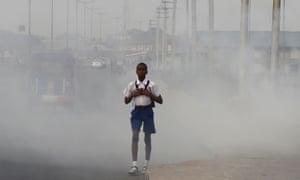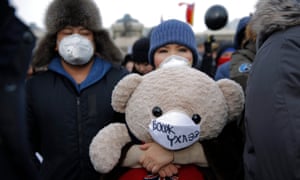EUROPE
Warsaw, Poland
“The air pollution problem in Poland is beyond any western standards. Despite poor conditions, Poland has done nothing to reduce used car imports, promote renewable energy, protect green areas or rationalise precaution levels. (Right now an alert is announced at 600% of the norm and the ministry for environment refuses to change that level because “they would have to announce the alert too often”.)
“Where I live (Warsaw) the air quality is very bad. The intensive development of apartment buildings in suburban areas without proper public transportation pushes people into cars and reduces green space. Over the last decade Warsaw suffered a net loss of 160,000 trees.
“Recently as more groups join the demand for better air, the city hall pretends they care, but there is no real action. I became a father five months ago and air quality has become a reason to stay indoors against our will for most of the winter. I’m a member of Warsaw’s city activist group Miasto Jest Nasze (the City is Ours), an organisation which set up Warsaw’s smog alert.” (Tymon Radwański)
London, UK
Ed H-B (@EdH_B)3 week old #airpollution filters frm cycling in Central #London – everyone should wear masks in #protest & tweet dirty filters! #cleanairnow pic.twitter.com/b34puftPGM
February 14, 2017
Bath, UK
“Levels of nitrogen dioxide on several roads leading into the city have exceeded the EU limits for years. It’s said that people living off the southern approach road into the city are likely to die nine years younger than those living on the hill on the opposite side of the city, three miles away.” (Louise Hidalgo, Bathampton Meadows Alliance)
AFRICA
Port Harcourt, Nigeria

“Residents of Port Harcourt became aware of a black substance falling from the sky last November. Authorities said an investigation was going to be carried out but not much happened until late January and early February when this pollution became unbearable.
“A lot of residents believed local refineries were the likely cause and took to social media to ask the state government to act. Finally, a committee was set up and a report released showing the soot is petroleum based, but the government said they couldn’t determine which activities were the cause.” (Babajide Odulaja)
“If you wipe surfaces indoors and outdoors with a white towel or tissue paper, you get a black smudge. Perhaps more worrisome is that if you clean your nostrils with a white material, you come up with a jet black residue. If you walk barefooted, the soles of your feet turn black.” (Eben Dokubo)
(Update: The situation was declared an emergency this week. According to reports the state government have shut down a Chinese construction company apparently responsible for the pollution.)
AMERICAS
Santiago, Chile
Envigado, Colombia
“Air pollution is visible here on most days. You can taste it in the air. I believe it’s caused by low-quality diesel, and the high number of motor vehicles. There is no rail system and freight is transported by road. Heavy vehicles emit a thick, black exhaust that is frightening to see and lingers in the air.” (Anonymous)
Mexico City, Mexico
Los Angeles, US
“I grew up in Los Angeles in the 50s and 60s. I remember days where the air pollution was so bad your eyes would burn and it hurt – actually was painful – to take a deep breath. Combine that with the heat and a shining grey sky that beat down on you, where the soup was so thick all you could see of the sun was a diffuse bright patch in the sky, where even the grass turned brown and the trees died from the pollution, and you have a hell on earth of the sort described by Tolkein when he wrote about the wastelands of Mordor.” (EvilMidnightBomber)
“I remember walking home from my grade school in the late 60s literally crying like I had been teargassed the air was so bad. My parents said it was even worse before incinerators were banned.” (MakeBeerNotWar)
ASIA
Shanghai, China
“We celebrate when we see blue sky and share pictures with each other on WeChat. I purchased an air purifier for my home – we have no idea if it helps. We just feel secure, it’s like buying insurance: you suddenly feel good.” (Artem)
“When the air pollution is bad, many people in my office develop coughs and sick days are taken. I like to walk or ride a bicycle home, but I always need to check the air quality before leaving work. Today I decided to take the bus home because the air quality reading was 150. I have also cancelled weekend plans with friends due to the unhealthy air levels. It can be very depressing.
“When the neighbouring city Hangzhou hosted the G20 and they shut down all the factories for two weeks it was amazing. Shanghai had clear blue skies the whole time. It shows if they really wanted to improve the quality of life and health of their residents they could, but they are not willing to unless a group of rich, powerful people are coming.” (Anonymous)
Beijing, China
Hong Kong
“Often, I don’t take my baby outside as I am so concerned about the effect on him. I wear a face mask on the days it is above an orange rating. My husband exercises at the gym instead of running when it’s bad. I often have a bitter taste or thick feeling on my mouth and tongue when I walk home at rush hour. This is a serious and scary problem, it’s obvious in the pollution visible on buildings, skin problems, difficulty breathing, chest pain and coughs.” (Anonymous)
Ulaanbaatar, Mongolia

“We are a part of the #BreatheMongolia and #MongolsAreSuffering initiatives. Protests and demonstrations in Ulaanbaatar have been raising awareness of the dangerous air pollution in the city and calling upon the government for solutions to the crisis as soon as possible. Thousands of demonstrators marched holding black balloons that represent their damaged lungs caused by air pollution and hung the balloons on the fence around the government house, aiming to show that around 500 children die annually in Mongolia due to air pollution.
“It has officially been declared that air pollution in Ulaanbaatar has reached disaster levels, exceeding 120 times the safe limit; 80% of the air pollution comes from the districts of ger (traditional circular felted tents) households, where people burn coal to stay warm.
“The top three diseases that resulted in the largest number of deaths in Mongolia in 2013 were air pollution-related. Studies show that air pollution exposure also results in miscarriage, premature birth and has an impact on the intellectual and physical development of a child. We know of someone who had multiple miscarriages while living in the city and had to move out to the countryside in order to give birth successfully. The people of Mongolia deserve clean air.” (Nomi Ganbold and JaRed Cameron)
Delhi, India
Sebastian Taylor (@DilliSeb)@guardiancities Taken last November mid morning here in Delhi. Only when this extreme did it become a (minor) political issue…for a week. pic.twitter.com/aVd0snXhuP
February 13, 2017
“I am asthmatic and air pollution makes me sick. In 2014 I packed up and left Delhi, moved to the mountains. But I have to keep coming back to the city and fighting air pollution has become a personal battle for me. I have seen healthy friends become sick in November 2016 as air pollution was at its peak. Tier two and tier three cities in India are worse though, there are no records on them and nothing to make people aware of it.” (Shibayan Raha)
“The air pollution in Delhi is actually pretty scary. I really haven’t ever experienced anything quite like it. There are days where I just have to stay inside because if I go out, I know the next day I’ll be struggling with sinus issues and laboured breathing. I have had a chronic cough since I have been here.
“Many people here, from young kids to athletic adults, to elders, all have this chronic congestive cough. We call it the Delhi chest, or the Delhi cough. Little kids with chronic respiratory illnesses are the norm here, not the rarity. And still they burn trash, run vehicles on diesel.
“I grew up in Los Angeles, and we had summer inversion layers that were probably the start of the reasoning for things like the Clean Air Act and the EPA. But the intensity of the physical symptoms I have here I have never experienced anywhere before.” (Nancy)
Guardian Cities is dedicating a week to investigating one of the worst preventable causes of death around the world: air pollution. Explore our coverage at The Air We Breathe and follow Guardian Cities on Twitter and Facebook to join the discussion
"You can taste it in the air": your stories of life in polluted cities
Hiç yorum yok:
Yorum Gönder